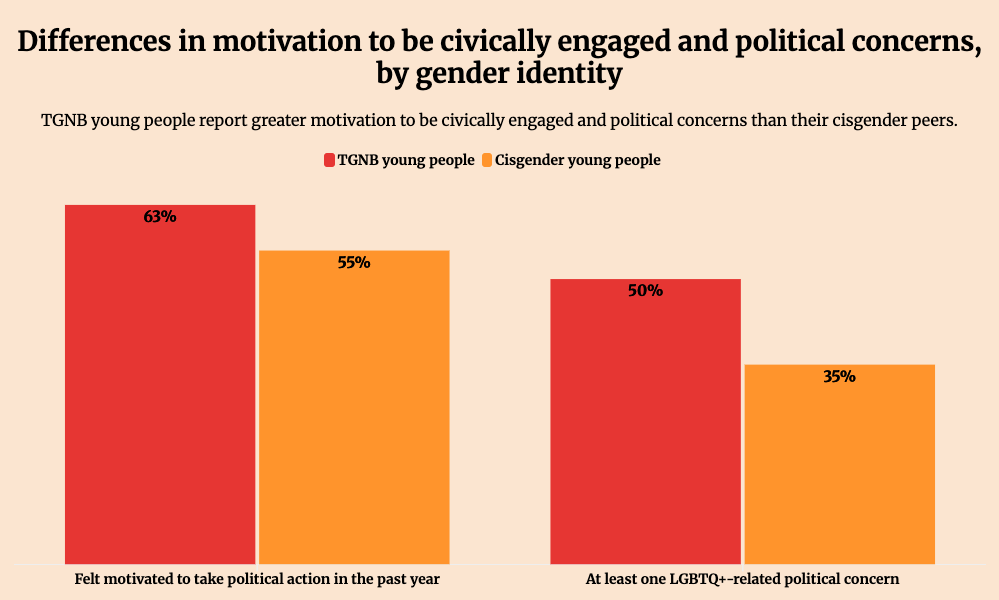Get stories like this delivered straight to your inbox. Sign up for The 74 Newsletter
Civic engagement among LGBTQ youth is on the rise, with 60% of 13- to 24-year-olds surveyed saying they were motivated to vote, give their money or time to a political cause, or reach out to leaders, new research from The Trevor Project finds.
But while political activism is linked to positive mental health outcomes for most young people, the picture is more complex for LGBTQ teens and young adults. Two in five reported having at least one concern impacting their lives, prompting them to consider whether to move to a different state or cross state lines to obtain health care.
“It’s a complex situation in that LGBTQ+ youth might feel more motivated to be engaged with political conversations or be civically engaged because they’re also more impacted by those anti-LGBTQ+ policies,” says Tiffany Eden, lead researcher on the report. “But at the same time, they’re also living with the repercussions.”
The survey was administered between the fall of 2022 and fall 2023, before President Donald Trump’s inauguration and his immediate attempts to roll back LGBTQ rights, Eden notes. More recent data, including dramatic increases in the number of calls to suicide prevention hotlines, indicate politics’ negative impact on queer youth has likely spiked since then.
Transgender and nonbinary youth were more likely to say they were motivated to take action than their cisgender peers: 63% versus 55%. Half of gender nonconforming youth reported having at least one LGBTQ-related political concern, compared to 35% of cisgender young people.
These political concerns can lead to mental health challenges, the survey showed. About 70% of those with at least one LGBTQ-related political concern reported recent anxiety, versus. 63% of those without worries. More than half of those with concerns, 56%, reported recent depression, compared to 50% of those without.
The problems were more significant for young people who said they were unable to meet their basic needs, with 52% harboring concerns compared to 43% whose needs are met.. Half of transgender and nonbinary young people had political concerns, versus 35% of cisgender peers.
Researchers also found geographic differences that frequently mirror the country’s political landscape, with 54% of those in the South saying they have concerns, vs. 47% in the Midwest, 37% in the West and 30% in the Northeast.
Differences in young people’s ability to get their needs met shows up in the data regarding specific types of civic engagement. For example, the vast majority of LGBTQ 18- to 24-year-olds were registered to vote, but the proportion drops for those facing barriers.
RelatedGen Z Has a Complex Relationship with Democracy, Survey Reveals
“That might be because they’re having more challenges or obstacles obtaining identification that aligns with their gender identity so that they can register to vote, and things like that,” says Eden. “That is probably one of the most important takeaways: That it looks different in LGBTQ+ youth in general, but even within that we see disparities and different groups that might need more support in order to be more engaged in the civic process.”
 The Trevor Project
The Trevor Project
Political engagement among those too young to vote was lower at 55%, compared to 64% of 18- to 24-year-olds. But even with more limited opportunities for engagement, the impact of recent policy changes is disproportionately felt by queer youth, says Eden.
“When you think about anti-LGBTQ plus policies that would impact young people, they’re impacting kids that are actually in schools,” she says. “These are bills about using bathrooms that align with your gender identity and playing on sports teams — things like that.”
Policies enabling in-school support are particularly important to LGBTQ youth. Slightly more than half say they are accepted by peers or teachers at school, compared with 40% who are supported at home.
The report is part of a series of analyses of longitudinal data Trevor compiles — which have taken on a more critical importance as some states ban or opt out of LGBTQ youth welfare data collections such as the U.S. Centers for Disease Control and Prevention’s Youth Risk Behavior Survey.
At the same time, the number of young people affected has risen sharply in recent years. Estimates vary depending on how data is tabulated, but in a recent Gallup survey, almost 2 million — or 9.5% — of teens ages 13 to 17 now identify as something other than straight or cisgender. That’s nearly twice as many as in 2020.
Did you use this article in your work?
We’d love to hear how The 74’s reporting is helping educators, researchers, and policymakers. Tell us how
